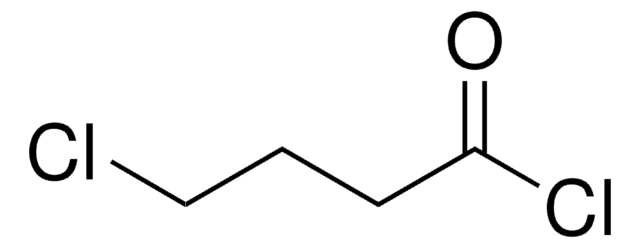563919
Aluminum chloride
anhydrous, powder, 99.999% trace metals basis
Synonym(s):
Aluminium trichloride, Aluminum(III) chloride, Trichloroaluminum
About This Item
Recommended Products
grade
anhydrous
vapor pressure
1 mmHg ( 100 °C)
Assay
99.999% trace metals basis
form
powder
reaction suitability
reagent type: catalyst
core: aluminum
impurities
≤15.0 ppm Trace Metal Analysis
mp
190 °C (lit.)
SMILES string
Cl[Al](Cl)Cl
InChI
1S/Al.3ClH/h;3*1H/q+3;;;/p-3
InChI key
VSCWAEJMTAWNJL-UHFFFAOYSA-K
Looking for similar products? Visit Product Comparison Guide
General description
Application
- To prepare cost-effective ionic liquid electrolyte for high performance aluminum ion battery.
- To fabricate modified SnO2 triple layered photoanode for dye sensitized solar cells. This leads to suppression of electron recombination and five-fold enhancement of efficiency.
- As a precursor to synthesize CsPbCl3 perovskite nanocrystals for bright white light-emitting diodes. It improves photoluminescence quantum yield.
Features and Benefits
- High purity with trace metal analysis (=< 15 ppm) makes suitable for batteries.
- High water solubility
- Stable under battery operation conditions
accessory
Signal Word
Danger
Hazard Statements
Precautionary Statements
Hazard Classifications
Eye Dam. 1 - Skin Corr. 1B
Supplementary Hazards
Storage Class Code
8B - Non-combustible corrosive hazardous materials
WGK
WGK 1
Flash Point(F)
Not applicable
Flash Point(C)
Not applicable
Personal Protective Equipment
Choose from one of the most recent versions:
Already Own This Product?
Find documentation for the products that you have recently purchased in the Document Library.
Customers Also Viewed
Articles
White solid-state light can be generated using three different approaches: By employing three diodes that emit red, green and blue light respectively, by using a near-UV LED that excites several phosphors that emit over the complete spectral range, or the third, most widely used alternative entailing down-conversion of a portion of blue LED light to longer wavelengths in such a manner that white light emerges.
Related Content
We offer a complete line of the highest purity inorganic salts and materials for the micro and nanoelectronics market.
Our team of scientists has experience in all areas of research including Life Science, Material Science, Chemical Synthesis, Chromatography, Analytical and many others.
Contact Technical Service





